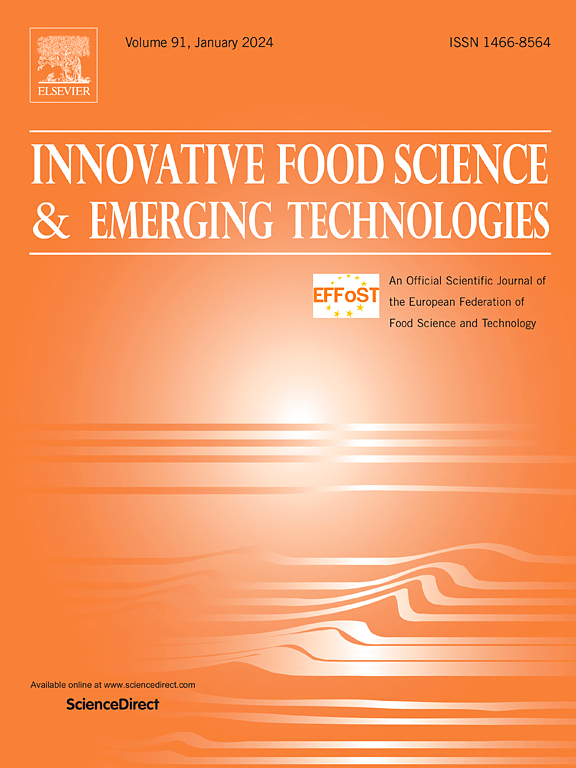Antifungal and anti-aflatoxigenic mechanisms of dielectric barrier discharge cold plasma on Aspergillus flavus spores
IF 6.3
1区 农林科学
Q1 FOOD SCIENCE & TECHNOLOGY
Innovative Food Science & Emerging Technologies
Pub Date : 2025-02-13
DOI:10.1016/j.ifset.2025.103964
引用次数: 0
Abstract
Aspergillus flavus and its toxic aflatoxins secondary metabolites can cause a serious threat to food safety and public health. Recently, dielectric barrier discharge cold plasma (DBD-CP) has exhibited a high-efficiency decontamination ability on A. flavus spores, whereas its action mechanism remains unclear. This research investigated the mechanisms of antifungal and anti-aflatoxigenic properties of DBD-CP on A. flavus spores. Our results indicated that the ratios of cell apoptosis and necroptosis after DBD-CP treatment for 40 s were 37.0 % and 35.8 %, respectively. Moreover, the intracellular reactive oxygen species (ROS) were accumulated by DBD-CP, which triggered apoptosis by the metacaspase-dependent mitochondrial pathway and necroptosis by the RIP1/RIP3 necrosome, respectively. Besides, DBD-CP could inhibit aflatoxin B1 production by regulating the expression of key genes (aflC, aflE and aflM) during the aflatoxin biosynthetic pathway. Hence, this work revealed new insight into the mechanisms of action by DBD-CP on A. flavus spores, providing a theoretical foundation for the application of DBD-CP in fungal inactivation and mycotoxin production.
Industrial relevance
This research revealed the antifungal mechanism by ROS-mediated apoptosis and necrosis, further exploring the anti-aflatoxigenic mechanism by inhibiting the expression of key genes in aflatoxin biosynthesis as well. These results contribute to the understanding of fungal inactivation and mycotoxin production by DBD-CP, accelerating the development of cold plasma in food decontamination.

介质阻挡放电冷等离子体对黄曲霉孢子的抗真菌和抗黄曲霉氧化机制
黄曲霉及其次生代谢产物黄曲霉毒素对食品安全和公众健康构成严重威胁。近年来,介质阻挡放电冷等离子体(DBD-CP)对黄曲霉孢子表现出了高效的去污能力,但其作用机制尚不清楚。本研究探讨了黄曲霉多糖对黄曲霉孢子的抗真菌和抗黄曲霉毒素作用机制。结果表明,DBD-CP治疗40 s后,细胞凋亡和坏死的比例分别为37.0%和35.8%。此外,DBD-CP积累细胞内活性氧(ROS),分别通过metacaspase依赖的线粒体途径引发细胞凋亡和RIP1/RIP3坏死体引发坏死凋亡。此外,DBD-CP可通过调节黄曲霉毒素生物合成途径中关键基因(aflC、aflE和aflM)的表达来抑制黄曲霉毒素B1的产生。本研究揭示了DBD-CP对黄曲霉孢子的作用机制,为DBD-CP在真菌灭活和真菌毒素生产中的应用提供了理论基础。本研究揭示了ros介导的细胞凋亡和坏死的抗真菌机制,并通过抑制黄曲霉毒素生物合成关键基因的表达进一步探索其抗黄曲霉毒素的机制。这些结果有助于了解DBD-CP对真菌失活和产生霉菌毒素的作用,加快冷等离子体在食品去污中的发展。
本文章由计算机程序翻译,如有差异,请以英文原文为准。
求助全文
约1分钟内获得全文
求助全文
来源期刊
CiteScore
12.00
自引率
6.10%
发文量
259
审稿时长
25 days
期刊介绍:
Innovative Food Science and Emerging Technologies (IFSET) aims to provide the highest quality original contributions and few, mainly upon invitation, reviews on and highly innovative developments in food science and emerging food process technologies. The significance of the results either for the science community or for industrial R&D groups must be specified. Papers submitted must be of highest scientific quality and only those advancing current scientific knowledge and understanding or with technical relevance will be considered.

 求助内容:
求助内容: 应助结果提醒方式:
应助结果提醒方式:


